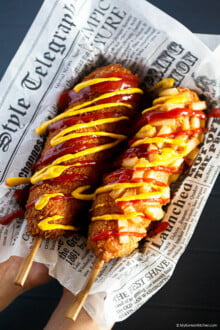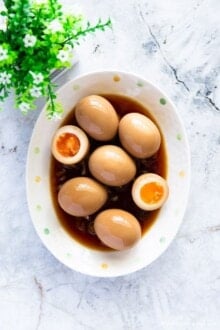These Korean flavor infused tuna patties are so delicious and flavorful without being overbearing. What’s more, it is breaded with panko breadcrumbs outside, making it especially crunchy and even more scrumptious.
It’s definitely one of our favorite ways of enjoying canned tuna!
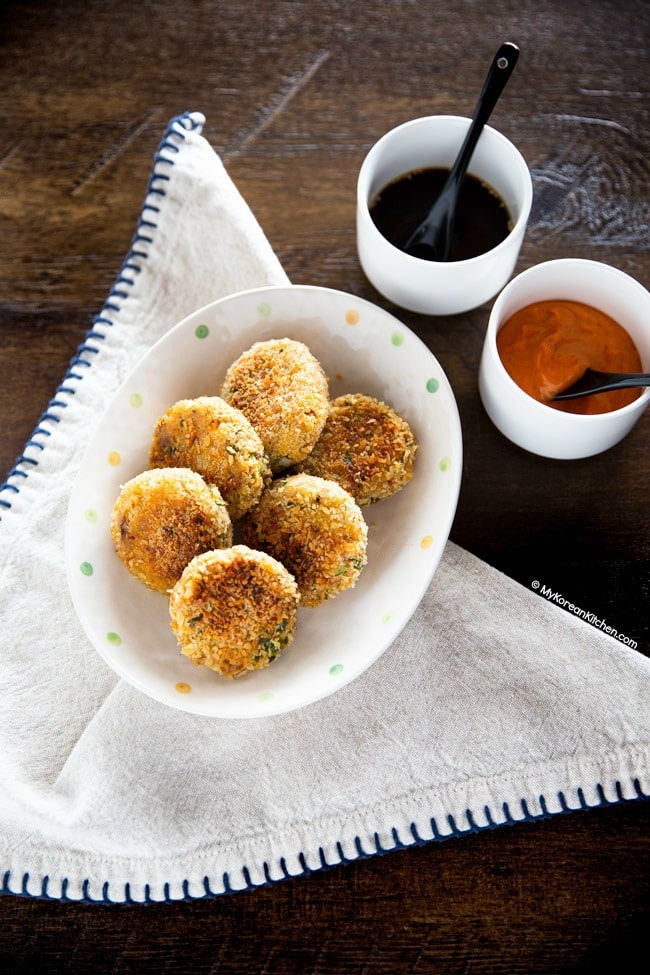
What is Gochujang Mayo Tuna Patties
Gochujang mayo tuna patties are made with canned tuna, eggs, finely diced vegetables, a bit of flour, fine sea salt and black pepper. (Up to this point, these are the same ingredients I used in my traditional Korean tuna pancake recipe! Mind you, the cooking technique is a bit different, so don’t discount either of the recipes! 😉)
What’s special about these tuna patties is that they are seasoned with gochujang (korean chili paste) and mayonnaise. Believe it or not, they go really well together. The slightly spicy (but not hugely noticeable) yet full of savory flavor gives a nice kick to otherwise bland canned tuna. Also, they provide extra moisture to the patties making them even more desirable!
On top of that, panko breadcrumbs are mixed in the patties, providing a nice little surprise texture. Then finally, it is generously coated with panko breadcrumbs again for the outer layers, giving us so much pleasure when you bite them.
Do you want to make these with me?
Tips for Success
- Drain – Make sure you drain the tuna well. I would do this as the first step of preparation, using a sieve. Unnecessary liquid increases the chances of patties falling apart.
- Dice – Make sure to dice the vegetables finely. If it’s a bit chunky, again, it increases the chances of patties breaking or falling apart.
- Substitutions
- One of the key ingredients used here is panko breadcrumbs. If you have trouble finding it, you may substitute it with regular breadcrumbs in equal portion. But the results are far superior when you use panko breadcrumbs in my opinion. On a side note, I also tried using polenta as it seemed to be a popular healthier alternative, but I have to say, it does not taste good. The texture isn’t right either.
- Another ingredient you might ask for substitution I suspect is gochujang. If you don’t have access to gochujang, you could try it with sriracha sauce. I never recommend sriracha sauce as a universal substitute for gochujang, but in this recipe it can work. Though, gochujang gives stronger and more balanced flavor in gochujang mayo sauce, so you may have to play with other ingredients for it to work as well as gochujang. E.g. possibly more salt and more panko breadcrumbs, as sriracha sauce is not as thick as gochujang. Just note that I didn’t perform extensive testing with sriracha sauce with this recipe.
- Cook Slowly – Be sure to cook the patties slowly over medium low heat with a lid on. Otherwise, it will burn the outer layers really fast while resulting in undercooked patties.
- Minimize Flipping – I only flip the patties twice during 15 mins of cooking. Less flipping means less chance of the patties breaking apart.
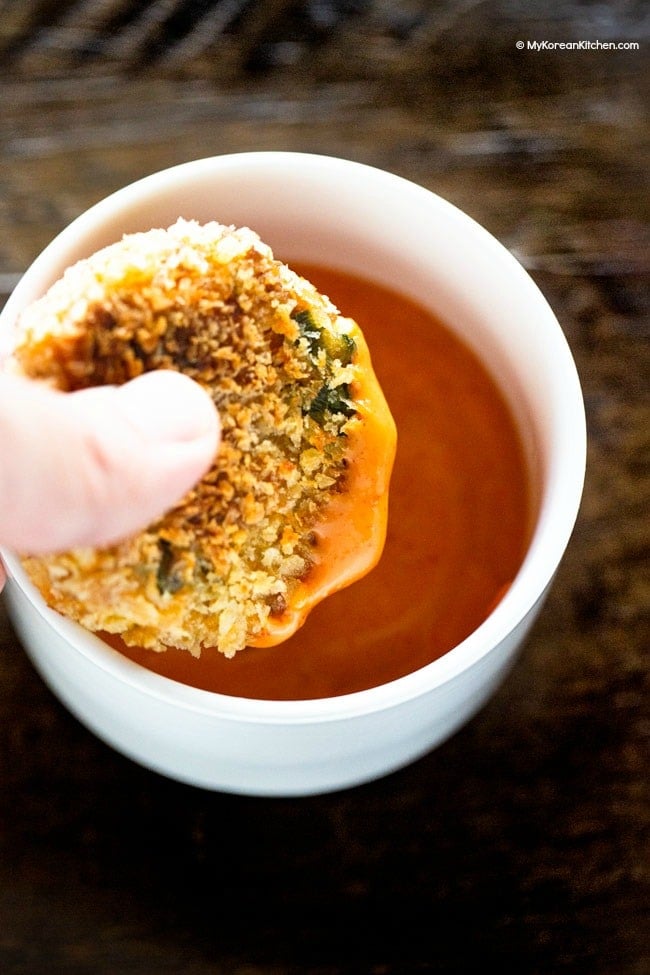
How to Serve
We normally eat these tuna patties with cooked rice, pickled radishes and radish kimchi. It makes a great banchan (Korean side dish). Of course, you are welcome to add any other Korean side dishes you may know of.
Also, I haven’t tried it yet, but I think they will be excellent as a burger patty too.
For the dipping sauce (because it’s always good to have some), we serve these tuna patties with gochujang mayo dipping sauce (for adults), ketchup (for kids) and Korean soy dipping sauce (for someone who appreciates Asian flavor).
In particular, gochujang mayo dipping sauce really intensifies the flavor of gochujang mayo tuna patties. It’s quite addictive as well.
Lastly, you can pair the patties with tartar sauce or aioli too. How versatile!
More Recipes with Tuna
A can of tuna can be transformed into other delicious recipes. Check out my other recipes!
- Tuna Mayo Rice Bowl
- Korean Tuna Pancakes
- Korean Spicy Tuna
INGREDIENTS FOR TUNA PATTIES (Makes 10 Small Patties)
Main
- 185g/6.5 ounces canned tuna, well-drained
- 2 large eggs, beaten
- 20g/0.7 ounces green onion, finely chopped
- 45g/1.6 ounces onion, finely chopped
- 20g/0.7 ounces red bell peppers or cayenne chili, seeded and finely chopped
- 20g / 0.7 ounces green bell peppers or cayenne chili, seeded and finely chopped
- 2 tsp all purpose flour
- 1/4 tsp fine sea salt
- 2 Tbsp mayonnaise (I used Hellmann’s real mayonnaise)
- 1 tsp gochujang (Korean chili paste)
- A few sprinkles of ground black pepper
- 1 cup panko (Japanese breadcrumbs) or regular breadcrumbs, divided into two half cups
- Some cooking oil (I used rice bran oil)
Gochujang Mayo Dipping Sauce
- 1/4 cup mayonnaise
- 2 tsp gochujang (Korean chili paste)
Soy Dipping Sauce
- 1 Tbsp soy sauce, regular (My go to soy sauce is Kikkoman brand)
- 1 Tbsp water
- 1 Tbsp rice wine vinegar
- 2 tsp sugar
* 1 Tbsp = 15 ml, 1 Cup = 250 ml
** If you want to learn more about Korean ingredients, check my essential Korean cooking ingredients list!
HOW TO MAKE GOCHUJANG MAYO TUNA PATTIES
1. Make your choice(s) of dipping sauce by whisking all ingredients in a bowl(s). Set aside.
2. Whisk well mayonnaise (2 Tbsp) and gochujang (1 tsp) in a small bowl. Combine canned tuna, eggs, green onion, onion, bell peppers, flour, salt, gochujang mayo sauce from earlier, and a 1/2 cup of panko breadcrumbs in a mixing bowl. Mix them well.
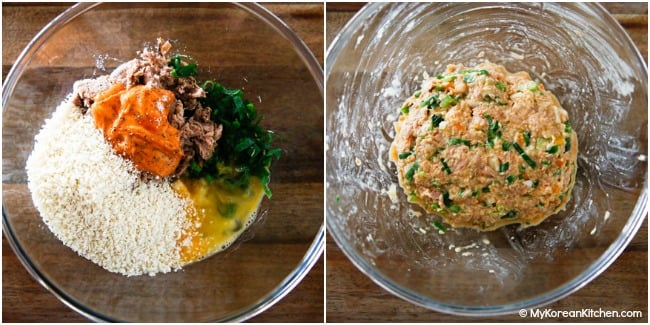
Place the remaining panko breadcrumbs in a wide bowl (e.g. pasta bowl). Shape the mixture into small balls. I use an ice cream scoop to make even sized patties.
As you make small balls of mixture, gently place them on panko and roll around to coat. Gently flatten the balls into patties with your hands. Coat with more panko and set aside. Repeat this with the remaining tuna mixture.
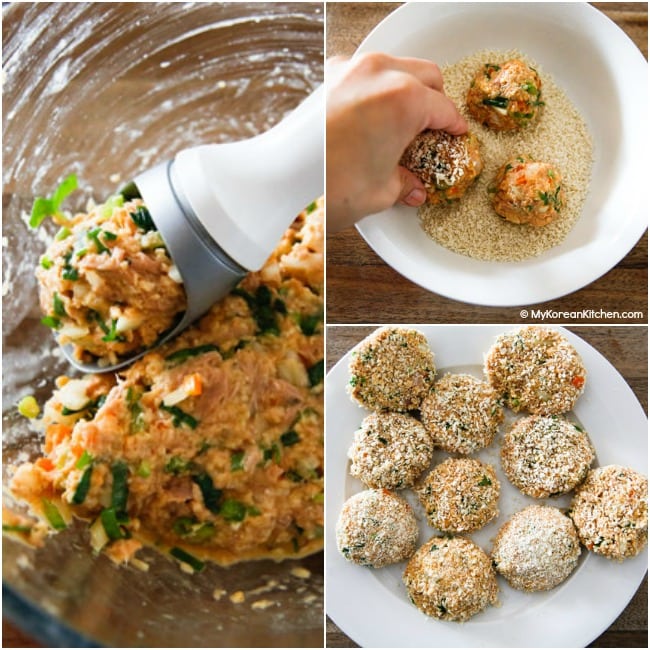
3. Stove Top Method – Preheat a skillet over medium low heat. Once heated, add some cooking oil and spread well. Gently place the tuna patties into the skillet (without over crowding) and cover with the lid, cook for 5 mins.
Add some oil over the tuna patties and flip them. Cook for a further 5 mins, covered. Flip once more and cook another 5 mins, or until golden brown.

Air Fryer Method – Spray the fryer basket with cooking spray. Gently place the tuna patties in the basket (without over crowding). Set the air fryer to 180 C / 356 F and cook for 8 to 10 minutes. Then flip the patties with tongs and cook for 8 to 10 minutes more, or until golden brown.
Oven Method – Preheat oven at 200 C / 392 F. Line a large baking sheet with baking paper. Gently place the tuna patties and lightly spray with cooking oil. Bake for 10 mins. Remove the tray from the oven, flip the patties, and lightly spray with some cooking oil. Return to oven and bake for another 10 mins or until golden brown.
4. Serve warm with your choice of dipping sauce (e.g. gochujang mayo dipping sauce, ketchup, soy dipping sauce, aioli, or tartar sauce).
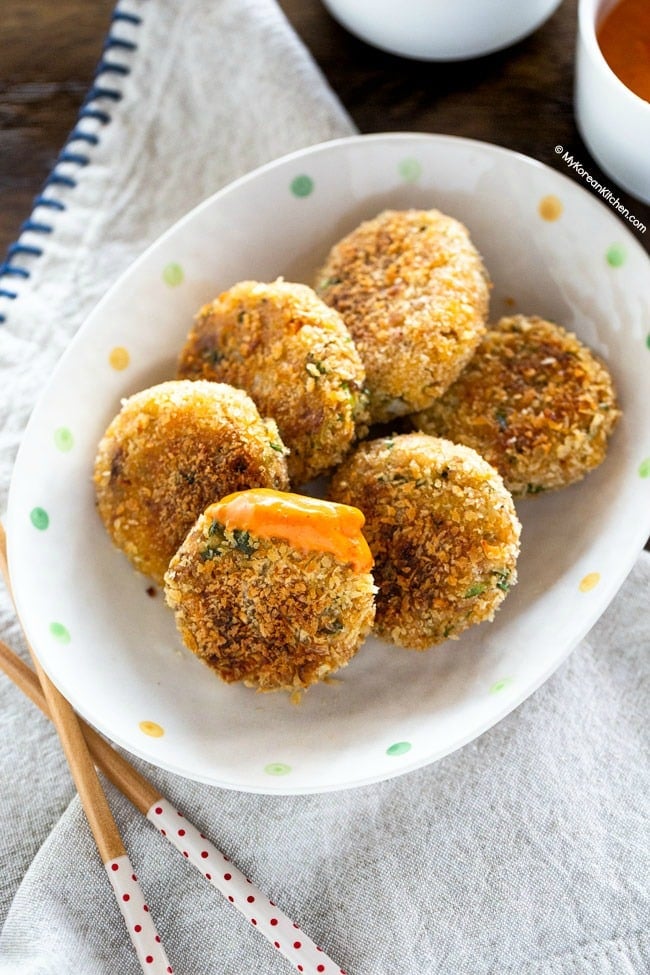
How To Store
One of the beauties of these tuna patties is that they are still tasty even after being reheated, without loosing too much crunchy texture.
You can refrigerate the leftover patties in an airtight container for 3 to 4 days. Enjoy reheated or cold.
For longer term, you can freeze them in an airtight container as well. These should be good for at least one month.
Love Korean food? Browse lots more Korean recipes from my easy Korean recipe collections. And subscribe to my newsletter for all of the latest updates including new recipes, what MKK communities are cooking and K-Dramas!

Gochujang Mayo Tuna Patties
Ingredients
MAIN
- 185 g canned tuna (6.5 ounces), well-drained
- 2 large eggs , beaten
- 20 g green onion (0.7 ounces), finely chopped
- 45 g onion (1.6 ounces), finely chopped
- 20 g red bell peppers or cayenne chili, (0.7 ounces), seeded and finely chopped
- 20 g green bell peppers or cayenne chili, (0.7 ounces), seeded and finely chopped
- 2 tsp all purpose flour
- 1/4 tsp fine sea salt
- 2 Tbsp mayonnaise (I used Hellmann’s real mayonnaise)
- 1 tsp gochujang (Korean chili paste)
- A few sprinkles ground black pepper
- 1 cup panko (Japanese breadcrumbs), or regular breadcrumbs, divided into two half cups
- Some cooking oil (I used rice bran oil)
GOCHUJANG MAYO DIPPIING SAUCE
- 1/4 cup mayonnaise
- 2 tsp gochujang (Korean chili paste)
SOY DIPPING SAUCE
- 1 Tbsp soy sauce , regular (My go to soy sauce is Kikkoman brand)
- 1 Tbsp water
- 1 Tbsp rice wine vinegar
- 2 tsp sugar
Instructions
- Make your choice(s) of dipping sauce by whisking all ingredients in a bowl(s). Set aside.
- Whisk well mayonnaise (2 Tbsp) and gochujang (1 tsp) in a small bowl. Combine canned tuna, eggs, green onion, onion, bell peppers, flour, salt, gochujang mayo sauce from earlier, and a 1/2 cup of panko breadcrumbs in a mixing bowl. Mix them well.Place the remaining panko breadcrumbs in a wide bowl (e.g. pasta bowl). Shape the mixture into small balls. I use an ice cream scoop to make even sized patties. As you make small balls of mixture, gently place them on panko and roll around to coat. Gently flatten the balls into patties with your hands. Coat with more panko and set aside. Repeat this with the remaining tuna mixture.
- Stove Top Method – Preheat a skillet over medium low heat. Once heated, add some cooking oil and spread well. Gently place the tuna patties into the skillet (without over crowding) and cover with the lid, cook for 5 mins. Add some oil over the tuna patties and flip them. Cook for a further 5 mins, covered. Flip once more and cook another 5 mins, or until golden brown.Air Fryer Method – Spray the fryer basket with cooking spray. Gently place the tuna patties in the basket (without over crowding). Set the air fryer to 180 C / 356 F and cook for 8 to 10 minutes. Then flip the patties with tongs and cook for 8 to 10 minutes more, or until golden brown.Oven Method – Preheat oven at 200 C / 392 F. Line a large baking sheet with baking paper. Gently place the tuna patties and lightly spray with cooking oil. Bake for 10 mins. Remove the tray from the oven, flip the patties, and lightly spray with some cooking oil. Return to oven and bake for another 10 mins or until golden brown.
Notes
Nutrition Info (per serving)
The nutrition information shown is an estimate provided by an online nutrition calculator. It should not be considered a substitute for a professional nutritionist’s advice.

